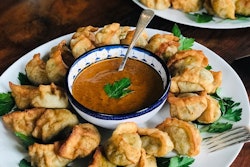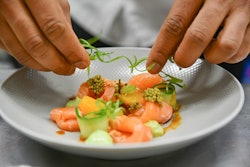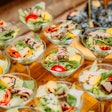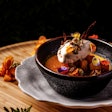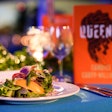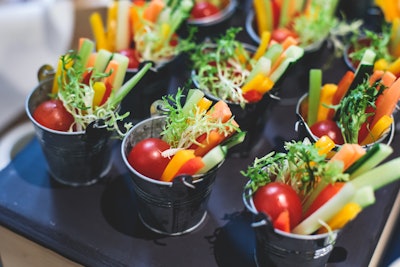
To get a clearer picture of what the future holds during a period of so much uncertainty, BizBash is planning a series of articles where top professionals from all aspects of the event industry share their predictions and insights for the year ahead.
Previously, we caught up with lighting and audiovisual producers, floral and event designers, and trade show and convention experts. Now, we're chatting with top caterers and F&B professionals. Here's an in-depth look at what six experts around the country are expecting to see in 2022.
1. Safety is still crucial when it comes to F&B experiences.
“Food safety, from preparation to presentation, will continue to be a top priority and concern,” says Carla Ruben, president of Creative Edge Parties—a catering and event planning company based in New York and South Florida—who observes that “rather than big companywide events, companies are planning more intimate and more intricate events for smaller groups, departments and divisions within the organization.” So how will that affect food-serving options? “You’re going to see more passed foods and individual servings, and less buffets in order to limit crowds and grazing,” she predicts.
Dana Pellicano, the vice president of global food and beverage, U.S and Canada, for Marriott International, agrees. “Guests want options that allow them to prioritize their safety without sacrificing experiences. This can mean sitting in small groups with people they trust to be ‘in their pod,’ or more space to distance in larger settings with mixed crowds,” she says.
Mary Cline, the Atlanta-based regional director of catering sales for Wolfgang Puck Catering, advises gauging an audience’s temperature regarding the return of face-to-face events, then curating the catering experience accordingly. “I think event and meeting attendees are looking for comfort, approachable luxury, and added thoughtful amenities or touch points to increase their level of comfort and sense of safety being back face-to-face—whether through including nostalgic fan-favorites on menus, interactive station menus that allow customization to the personal level, or packaged takeaways for an extra special feeling as they depart an event.”
But if any industry is prepared to do their job safely, it’s the food and beverage industry, which has always been prepared for viruses, bacteria and cross-contamination, notes Thomas Whelan, Levy Restaurants' director of banquets at the Boston Convention and Exhibition Center. “We've been raised on answering questions on how we can maintain safety for our clients,” he says. “For really great caterers and food providers, health and safety has always been at the forefront.”
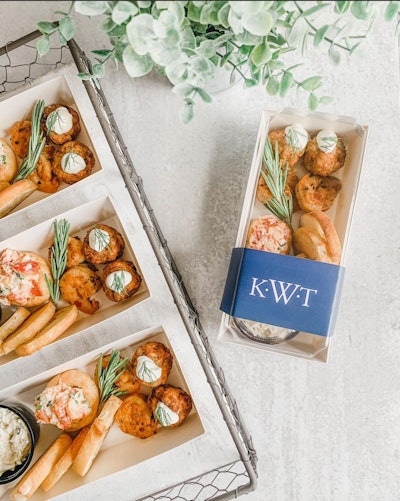 Susan Lacz of Ridgewells Catering says that in 2022, it’s all about “individually packaged food items, creatively displayed and branded. Whether it be a cone, a mini pizza box or a bento box, these displays are here to stay.”Photo: Courtesy of Ridgewells Catering
Susan Lacz of Ridgewells Catering says that in 2022, it’s all about “individually packaged food items, creatively displayed and branded. Whether it be a cone, a mini pizza box or a bento box, these displays are here to stay.”Photo: Courtesy of Ridgewells Catering
The focus on safety has led to some innovative serving techniques—and our experts expect that trend to continue. “I think we can say goodbye to the big buffets in the near future,” predicts Susan Lacz, CEO and principal for Ridgewells Catering near Washington, D.C. “It’s more about individually packaged food items, creatively displayed and branded. Whether it be a cone, a mini pizza box or a bento box, these displays are here to stay.”
Ruben observes a similar trend. “You’re going to see more composed small plates and roaming stations where people simply pick up a styled dish rather than serve themselves from a station. You are also going to see hors d’oeuvres served in more ways that are creatively designed while prioritizing safety. Think trays with ‘dresser style’ drawers or stacked vertically with dividers that separate one portion from the next. It’s become one of the most popular requests for our events over the past few months.”
3. Guests are looking for bold and unconventional flavors.
“When everyone was on lockdown, people explored more food,” notes Whelan, joking that he blames Trader Joe’s spices for the trend. “People have much more welcoming palettes to new flavors. So we're seeing a rise in requests for Za'atar and saffron and different curries—things that people were always hesitant to add to menus. People want to experiment now with interesting, unique, regional flavors.”
“People are experience-starved and ready to be wowed,” adds Pellicano. “They want food they didn’t learn to make at home—so less banana bread and more hand-pulled noodles. And, if people are traveling for a meeting, they definitely want a sense of place from the event space. They’ll want the food to taste of the region since so many people didn’t get to travel for the past 20 months.”
Pellicano also observes an increased interest in food and flavors from Asia Pacific, outside of greater China. “For a few years, industry analysts have anticipated that Filipino food would go more mainstream, and you’re starting to see it in major metro areas like New York, Los Angeles, Washington, D.C. and Chicago,” she says. “Several beloved Korean steak and chicken restaurants have announced major growth plans in the U.S.—I think you’ll see broad adoption of this into our national food lexicon the way Thai food really became mainstream so many years ago.”
4. Also, elevated takes on traditional foods.
Whelan also notes that, right now, many attendees want “innovative spins on classic comfort food. We do this really amazing action station with a huge marshmallow and we basically briquette s'mores with it,” he says. “I had another person request a unique and different chicken and waffle, and another request an elevated corn dog. People always want something elevated and unique, but they still want it to be within their comfort zone.”
“After a stressful and difficult two years, people are yearning for minimal, no-frills interpretations of classic meals and comfort foods that bring you back to your childhood," agrees Ruben. “Expect to see elevated takes on foods that have gone viral on TikTok, like salmon rice bowls.”
Tara Newman, private and special events manager for RPM Events, a restaurant and event venue group based in Chicago, sums it up: “[Guests] are looking for sophisticated dishes that are out of the ordinary, but still recognizable,” she explains.
5. Specialty cocktails are having a moment.
“Specialty drinks are no longer just for weddings,” observes Lacz. “Our clients want to add a special something to their events and they do it through signature drinks. Many varieties of the traditional Moscow Mule and—I’m happy to report—the Martini and Manhattan are back in full force and requested often—maybe with a twist, no pun intended. Bar garnish is huge, not just lemons and limes but dried citrus wedges and fresh herbs.”
Ruben agrees. “Almost every event we have done recently has involved elevated cocktails—lots of celebratory beverages such as CBD-infused drinks or juices infused with herbs,” she says, noting that Creative Edge recently created its own beverage and mixology division to be able to experiment and develop new concepts. “Other trends you’ll see more of include bottled cocktails; non-alcoholic cocktails that are designed to be delicious without being boring and sugary; more agaves like Sotol, and Mezcal. And watch for rum to make a comeback!”
Newman adds, “Tequila drinks and Old-Fashioneds are having a moment, and the clients are much more well versed in the world of spirits and have requests for certain brands and labels.” Cline, meanwhile, is observing a focus on local craft liquors and unique ingredients used to create twists on traditional cocktail recipes.”
6. As are nonalcoholic beverages.
Ruben isn’t the only one noticing an increased desire for alcohol-free drinks at events. Pellicano notes that industry analysts are predicting 400% growth in the low- and no-ABV cocktail category. “Increasingly, companies are producing delicious, high-quality zero-proof spirits that can be used in the same way as traditional gin, wine or other mixers,” she says. “Pushing way beyond the juice or soda-based mocktails of the past, these highly crafted beverages are unlocking new experiences for sober-minded consumers.”
“Zero-proof beverages are not a trend—they’re one of the most important things we can do,” agrees Whelan. “I just did an event for 16 people, and there were four people who have chosen to not include alcohol into their lives. If we didn't have a signature drink, they would've just been sipping soda or water while everyone else is having this really great curated cocktail. We want all of our attendees at any of our events to be able to be a part of the special—so crafting a seasonal nonalcoholic drink is so important.”
7. Clients care about sustainability right now.
Several of our experts pointed out that conversations surrounding sustainability have been ramping up lately. “I think as quickly as folks feel safe, there will be a return to focused efforts away from bottled beverages and disposables, a return to the ‘greening’ of the industry that COVID sent sideways for safety reasons,” predicts Cline.
Pellicano is observing a focus on alternative milks and meats. “In today’s world, there is an increased desire for sustainable and responsible sourcing of ingredients,” she says, noting that “at Marriott, we are working to help address some of the world’s most pressing environmental and social issues, including sustainability, food waste reduction, reducing the use of single-use plastics and disposables across our operations, and working across our supply chain to create a more sustainably-sourced food and beverage experience.”
Ruben has also been working to eliminate plastic. “Customers are prioritizing sustainability and are demanding plastic-free events. They want to work with companies that don’t produce a lot of waste, utilize reusable plates, glasses and utensils, and compost waste and recycle,” she says.
8. There will be a bigger focus on healthy eating and specialty diets.
“We’re also seeing an increased focus on healthier trends and food offerings—for example, the rise in popularity of fermented foods and probiotics, and even prebiotic sodas spiked with apple cider vinegar,” says Pellicano.
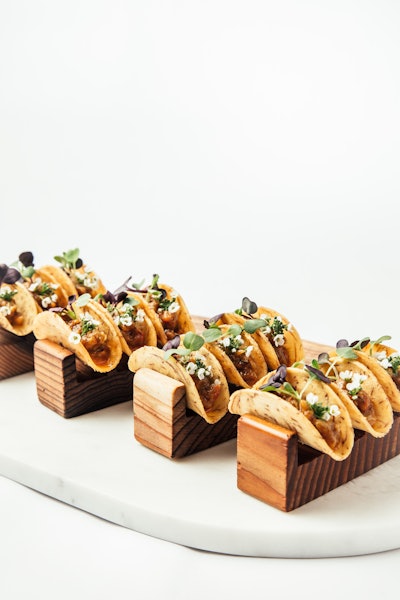 Mary Cline says that sometimes as many as half an event’s attendees are now requesting vegetarian options, like Wolfgang Puck Catering’s taro root taco (pictured).Photo: Courtesy of Wolfgang Puck Catering
Mary Cline says that sometimes as many as half an event’s attendees are now requesting vegetarian options, like Wolfgang Puck Catering’s taro root taco (pictured).Photo: Courtesy of Wolfgang Puck Catering
Cline expects gluten-free menus to explode in popularity in 2022. “What was once a small request for modifications and alternate meals is becoming more of a complete menu driver,” she says. The same goes for vegetarian options. “Vegetarian alternates were historically 10% of event attendees and now are sometimes as much as nearly half of an event’s attendees."
She continues, "While the occasional celebratory meal selections may still include the old ‘filet mignon’ standby, between the rising costs of meat, supply chain challenges and more attention paid to individuals’ diets and health, vegetables and healthy grains are moving to the forefront of the plate. Cauliflower, broccolini, quinoa, farro, pilafs made with mixed grains and seasonal vegetables with global flavors—chefs are getting more and more creative by the year, and event planners and attendees are eating it up.”
Ruben is seeing a similar trend. “People are hungry for more plant-based culinary options and you are going to see more entirely vegan menus and events. We are at a point where the demand is growing beyond the plant-based brands you can get in the grocery store. People want special delicacies like plant-based bacon, artisanal vegan cheeses and vegan renditions of traditional hors d'oeuvres,” she says.
9. Supply chain issues may affect menu items.
As Cline mentioned, the industry is dealing with rising costs of meat, making options like filet mignon less of a standby. Whelan predicts that the industry might also see fewer chicken and shrimp dishes in 2022 due to rising prices. “As we deal with these outsourcing and procurement issues, the cost of food is going to really start changing selection,” he says. “People are going to be looking for alternatives to the things we’ve always had, because it is so expensive or so hard to get.”
“The supply chain remains a challenge, and we need to remain nimble and knowledgeable to quickly address and provide solutions,” agrees Cline.
10. The industry will continue finding ways to strengthen itself in the wake of labor shortages, supply chain issues and other challenges.
“COVID exposed, but didn’t create, the fragility of what has always been a labor-intensive, high-cost business,” notes Pellicano. “I hope this means we’ll see an increased conscientiousness around sourcing and talent management, allowing us to create a more sustainable future for the industry.”
Lacz hopes that caterers will use 2022 to really examine their contracts and business practices. “I’m hopeful that we will get back to some normalcy,” she says. “As a result, we have looked long and hard at our catering contracts with clients for this ever-changing world—events get canceled so quickly and we need to better protect ourselves."
Ruben notes that the most challenging part of the pandemic has been a fear of commitment on the part of clients. “They are understandably concerned that spikes or new protocols will upend their plans,” she notes. “Last-minute events were rare before COVID, but now they are the norm. It’s a challenge that we face daily. We are constantly evaluating and evolving and developing new ways to best serve our clients as we navigate this challenging new landscape.”
Amid the uncertainty, Whelan hopes food and beverage professionals remember that it’s OK to say no. “Sometimes saying no to someone else is just saying yes to yourself. People were out of work for so long, and now they're doing six events in one day when they were, in their peak, only doing two—because the money's there, the events are back,” he observes. “So I hope that when we turn the corner into 2022, the fear of losing it all goes away, and instead people are able to manage themselves better, and not give up the time they were able to spend with loved ones.”
11. The face-to-face event industry is primed to bounce back strong than ever.
“In the next year, I believe that we will see more celebrations!” says Newman. “People are excited to get out and have missed the social aspect of their lives. Barring any major setbacks or government mandates, event calendars will continue to fill up.”
Pellicano thinks the last two years have really helped solidify the power of in-person gatherings. “There’s so much that comes from the energy of a group, collaborating together, and tackling big business imperatives as a team,” she says. “I also hope that long-delayed celebrations can finally be realized. We lost so much joy that comes from celebrating together, and I hope 2022 renews that for millions of people—over cake-cutting and Champagne toasts, of course!”
Cline adds, “At the beginning of the pandemic, I said that the catering industry is comprised of highly creative problem solvers and innovators. My biggest hope for catering in 2022 is to be a part of the industry that comes raging back with innovations to help event attendees feel comfortable, safe and excited about getting back to business face to face.”




